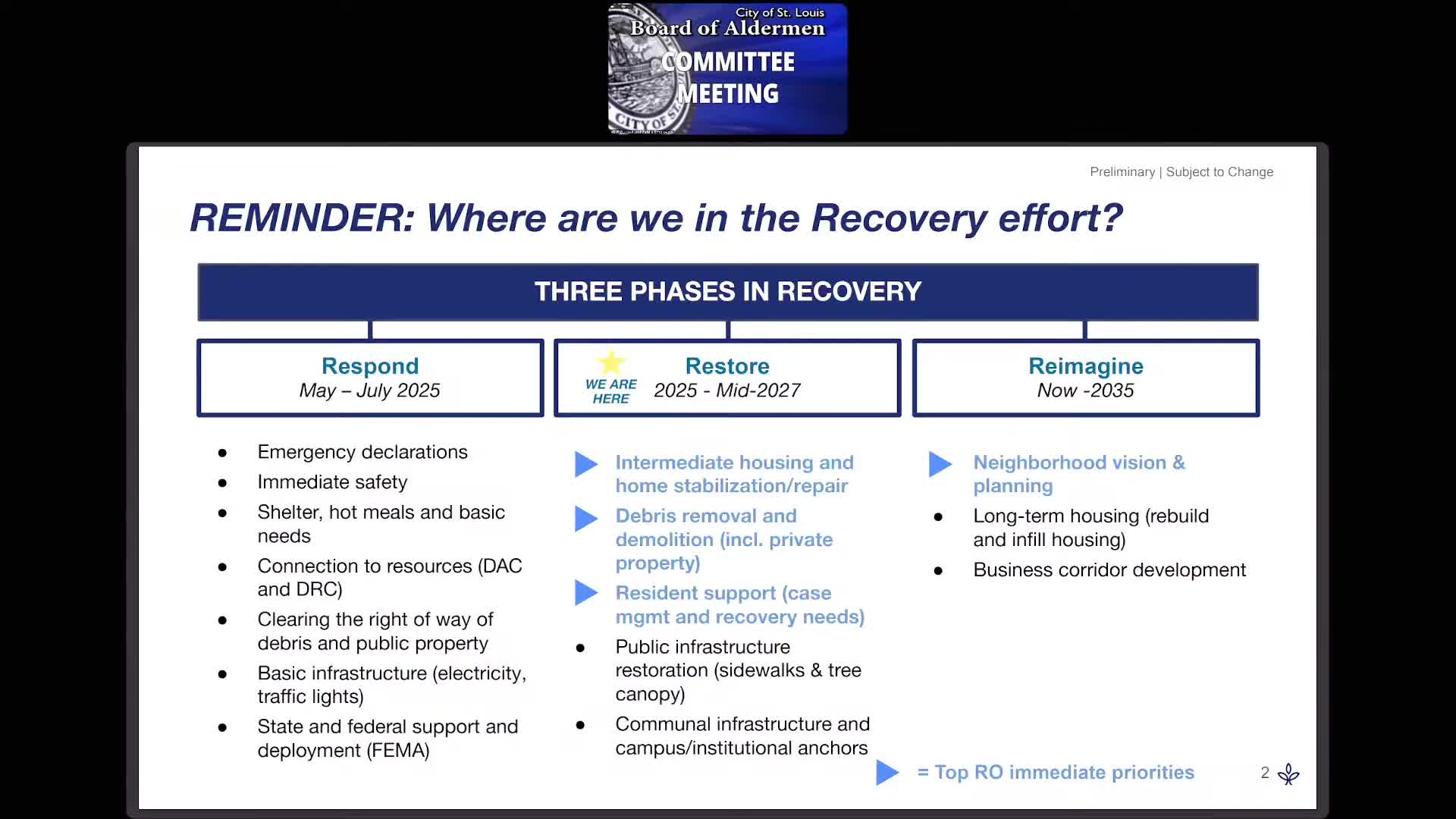Saint Louis Recovery Office Unveils Housing and Community Support Strategies Post-Tornado
September 05, 2025 | St. Louis City, St. Louis County, Missouri
This article was created by AI summarizing key points discussed. AI makes mistakes, so for full details and context, please refer to the video of the full meeting. Please report any errors so we can fix them. Report an error »

The Budget and Public Employees Committee of St. Louis convened on September 4, 2025, to discuss critical recovery efforts following recent tornado damage. The meeting highlighted the city's strategic focus on restoring public infrastructure, including housing, communal spaces, and essential services, as part of a broader vision for neighborhood revitalization.
A key topic was the urgent need for housing stabilization as winter approaches. Committee members emphasized the importance of ensuring that residents have access to safe and secure housing. This includes ongoing debris removal and demolition of unsafe structures, as well as the establishment of resource hubs to support affected residents. These hubs will provide case management and essential services, facilitating a smoother recovery process.
The committee outlined five primary priorities for the recovery office: caring for residents, debris removal, housing restoration, community planning, and economic revitalization. These priorities will guide the city's efforts as it navigates the complexities of recovery and rebuilding.
In terms of housing, the committee discussed both immediate and long-term strategies. Immediate housing solutions focus on stabilization and repair for existing homes, while longer-term plans involve constructing new housing units. The city aims to maximize available intermediate housing options within the next six to twelve months, addressing the pressing need for affordable housing in the wake of the tornado.
Additionally, the committee explored the establishment of community resource hubs designed to provide ongoing support for residents. These hubs will not only address immediate needs but also foster emotional and mental health recovery, recognizing the trauma experienced by many residents.
The meeting concluded with a commitment to collaborate with local community organizations, ensuring that recovery efforts are community-driven and responsive to the needs of those affected. As the city moves forward, the focus will remain on creating a resilient infrastructure that supports both immediate recovery and long-term community development.
A key topic was the urgent need for housing stabilization as winter approaches. Committee members emphasized the importance of ensuring that residents have access to safe and secure housing. This includes ongoing debris removal and demolition of unsafe structures, as well as the establishment of resource hubs to support affected residents. These hubs will provide case management and essential services, facilitating a smoother recovery process.
The committee outlined five primary priorities for the recovery office: caring for residents, debris removal, housing restoration, community planning, and economic revitalization. These priorities will guide the city's efforts as it navigates the complexities of recovery and rebuilding.
In terms of housing, the committee discussed both immediate and long-term strategies. Immediate housing solutions focus on stabilization and repair for existing homes, while longer-term plans involve constructing new housing units. The city aims to maximize available intermediate housing options within the next six to twelve months, addressing the pressing need for affordable housing in the wake of the tornado.
Additionally, the committee explored the establishment of community resource hubs designed to provide ongoing support for residents. These hubs will not only address immediate needs but also foster emotional and mental health recovery, recognizing the trauma experienced by many residents.
The meeting concluded with a commitment to collaborate with local community organizations, ensuring that recovery efforts are community-driven and responsive to the needs of those affected. As the city moves forward, the focus will remain on creating a resilient infrastructure that supports both immediate recovery and long-term community development.
View full meeting
This article is based on a recent meeting—watch the full video and explore the complete transcript for deeper insights into the discussion.
View full meeting
